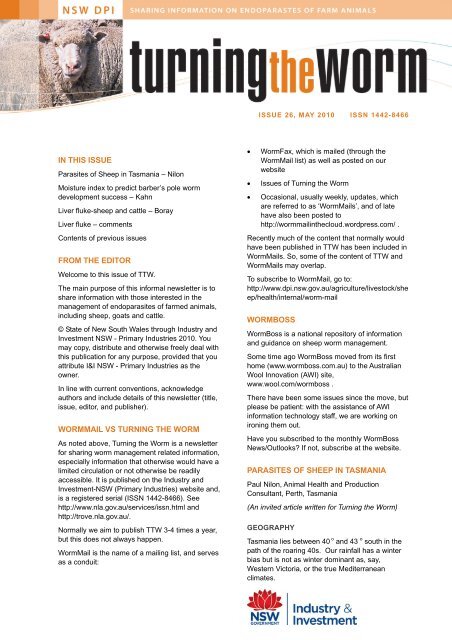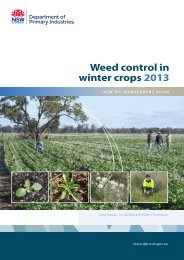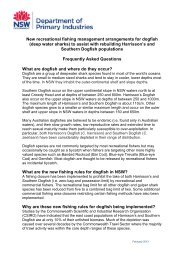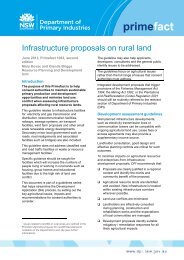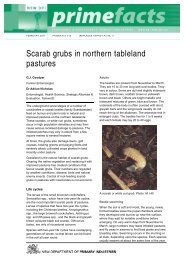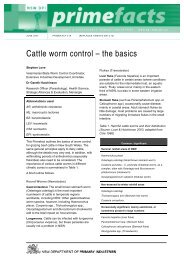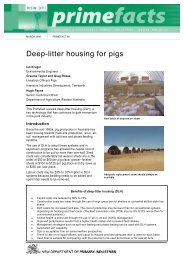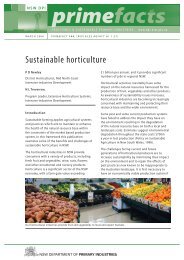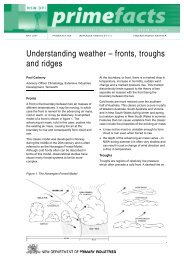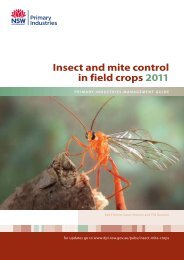Turning the Worm - NSW Department of Primary Industries
Turning the Worm - NSW Department of Primary Industries
Turning the Worm - NSW Department of Primary Industries
Create successful ePaper yourself
Turn your PDF publications into a flip-book with our unique Google optimized e-Paper software.
IN THIS ISSUE<br />
Parasites <strong>of</strong> Sheep in Tasmania – Nilon<br />
Moisture index to predict barber’s pole worm<br />
development success – Kahn<br />
Liver fluke-sheep and cattle – Boray<br />
Liver fluke – comments<br />
Contents <strong>of</strong> previous issues<br />
FROM THE EDITOR<br />
Welcome to this issue <strong>of</strong> TTW.<br />
The main purpose <strong>of</strong> this informal newsletter is to<br />
share information with those interested in <strong>the</strong><br />
management <strong>of</strong> endoparasites <strong>of</strong> farmed animals,<br />
including sheep, goats and cattle.<br />
© State <strong>of</strong> New South Wales through Industry and<br />
Investment <strong>NSW</strong> - <strong>Primary</strong> <strong>Industries</strong> 2010. You<br />
may copy, distribute and o<strong>the</strong>rwise freely deal with<br />
this publication for any purpose, provided that you<br />
attribute I&I <strong>NSW</strong> - <strong>Primary</strong> <strong>Industries</strong> as <strong>the</strong><br />
owner.<br />
In line with current conventions, acknowledge<br />
authors and include details <strong>of</strong> this newsletter (title,<br />
issue, editor, and publisher).<br />
WORMMAIL VS TURNING THE WORM<br />
As noted above, <strong>Turning</strong> <strong>the</strong> <strong>Worm</strong> is a newsletter<br />
for sharing worm management related information,<br />
especially information that o<strong>the</strong>rwise would have a<br />
limited circulation or not o<strong>the</strong>rwise be readily<br />
accessible. It is published on <strong>the</strong> Industry and<br />
Investment-<strong>NSW</strong> (<strong>Primary</strong> <strong>Industries</strong>) website and,<br />
is a registered serial (ISSN 1442-8466). See<br />
http://www.nla.gov.au/services/issn.html and<br />
http://trove.nla.gov.au/.<br />
Normally we aim to publish TTW 3-4 times a year,<br />
but this does not always happen.<br />
<strong>Worm</strong>Mail is <strong>the</strong> name <strong>of</strong> a mailing list, and serves<br />
as a conduit:<br />
ISSUE 26, MAY 2010 ISSN 1442-8466<br />
• <strong>Worm</strong>Fax, which is mailed (through <strong>the</strong><br />
<strong>Worm</strong>Mail list) as well as posted on our<br />
website<br />
• Issues <strong>of</strong> <strong>Turning</strong> <strong>the</strong> <strong>Worm</strong><br />
• Occasional, usually weekly, updates, which<br />
are referred to as ‘<strong>Worm</strong>Mails’, and <strong>of</strong> late<br />
have also been posted to<br />
http://wormmailin<strong>the</strong>cloud.wordpress.com/ .<br />
Recently much <strong>of</strong> <strong>the</strong> content that normally would<br />
have been published in TTW has been included in<br />
<strong>Worm</strong>Mails. So, some <strong>of</strong> <strong>the</strong> content <strong>of</strong> TTW and<br />
<strong>Worm</strong>Mails may overlap.<br />
To subscribe to <strong>Worm</strong>Mail, go to:<br />
http://www.dpi.nsw.gov.au/agriculture/livestock/she<br />
ep/health/internal/worm-mail<br />
WORMBOSS<br />
<strong>Worm</strong>Boss is a national repository <strong>of</strong> information<br />
and guidance on sheep worm management.<br />
Some time ago <strong>Worm</strong>Boss moved from its first<br />
home (www.wormboss.com.au) to <strong>the</strong> Australian<br />
Wool Innovation (AWI) site,<br />
www.wool.com/wormboss .<br />
There have been some issues since <strong>the</strong> move, but<br />
please be patient: with <strong>the</strong> assistance <strong>of</strong> AWI<br />
information technology staff, we are working on<br />
ironing <strong>the</strong>m out.<br />
Have you subscribed to <strong>the</strong> monthly <strong>Worm</strong>Boss<br />
News/Outlooks? If not, subscribe at <strong>the</strong> website.<br />
PARASITES OF SHEEP IN TASMANIA<br />
Paul Nilon, Animal Health and Production<br />
Consultant, Perth, Tasmania<br />
(An invited article written for <strong>Turning</strong> <strong>the</strong> <strong>Worm</strong>)<br />
GEOGRAPHY<br />
Tasmania lies between 40 o and 43 o south in <strong>the</strong><br />
path <strong>of</strong> <strong>the</strong> roaring 40s. Our rainfall has a winter<br />
bias but is not as winter dominant as, say,<br />
Western Victoria, or <strong>the</strong> true Mediterranean<br />
climates.
Despite its “Just like England” reputation, many<br />
areas <strong>of</strong> Tasmania are too predictably dry, and<br />
combined with <strong>the</strong> cold winters <strong>the</strong> sou<strong>the</strong>rn<br />
midlands and Derwent Valley look more like <strong>the</strong><br />
Monaro 1 than any part <strong>of</strong> England.<br />
Mild summers favour larval survival and<br />
environmental decontamination only works some<br />
years.<br />
SHEEP INDUSTRY<br />
Like many areas on <strong>the</strong> mainland our sheep<br />
numbers have declined from approximately 4.5<br />
million in 1990 to about 2.5 million now. Fur<strong>the</strong>r,<br />
meat sheep have replaced merinos and we<strong>the</strong>rs<br />
are almost extinct.<br />
Although sheep are found all over <strong>the</strong> State, <strong>the</strong><br />
numbers are small in <strong>the</strong> high rainfall, intensively<br />
farmed areas on <strong>the</strong> north coast. Most sheep still<br />
live in <strong>the</strong> drier Midlands, Derwent Valley and East<br />
Coast. Over much <strong>of</strong> this area <strong>the</strong> long-term<br />
rainfall is 400 to 600mm, with prolonged drought<br />
reducing this in recent years.<br />
While renowned for its superfine Saxon wool, <strong>the</strong><br />
fact is that <strong>the</strong> majority <strong>of</strong> <strong>the</strong> Tasmanian clip is a<br />
medium fine one, and getting stronger by <strong>the</strong> day<br />
as producers scramble to get greater body size to<br />
facilitate lamb production.<br />
Many farms are irrigated, and on <strong>the</strong>se places<br />
specialist prime lamb production fits better than<br />
wool.<br />
WORM SPECIES<br />
Our fulminating, uncontrolled parasitism is caused<br />
by Trichostrongylus vitrinus 2 in mid to late winter.<br />
Wet years are particularly suitable for this species<br />
to cause problems. In 2002 sheep <strong>of</strong> all classes<br />
and ages were laid low by a particularly bad<br />
season for worms. Trichs seem to disappear from<br />
late spring to late May.<br />
Teladorsagia (Ostertagia) circumcincta 3 is<br />
present year round, but predominates in late<br />
spring, and again in <strong>the</strong> autumn and early winter.<br />
It is most likely to be our drench-resistant worm,<br />
but its predations are rarely as severe as those <strong>of</strong><br />
Trich.<br />
1<br />
The Monaro is a region in sou<strong>the</strong>rn <strong>NSW</strong> and is in a rain<br />
shadow. Average annual rainfall varies from 470 to 700 mm.<br />
http://en.wikipedia.org/wiki/Monaro,_New_South_Wales<br />
2 One <strong>of</strong> <strong>the</strong> species <strong>of</strong> ‘black scour worm’.<br />
3 (Small) brown stomach worm.<br />
TURNING THE WORM ISSUE 26 MAY 2010<br />
Nematodirus spp 4 (don’t ask which species)<br />
predominates in dry summers and autumns.<br />
While it is regarded as relatively benign in o<strong>the</strong>r<br />
parts, in Tasmania it can cause significant<br />
parasitism, particularly in weaners. Moreover,<br />
because <strong>of</strong> sporadic egg output FEC 5 triggers for<br />
treatment are low (150epg).<br />
Haemonchus 6 is a sporadic problem on <strong>the</strong> East<br />
Coast and on Flinders Island. It is occasionally<br />
found in sheep and cattle on irrigated pastures in<br />
late summer, so it may become more important in<br />
time. O<strong>the</strong>r species (Cooperia,<br />
Oesophagostomum and T. axei) 7 are frequent<br />
incidental findings from larval diffs, but are not<br />
regarded as important.<br />
Fluke 8 is found in <strong>the</strong> range country on <strong>the</strong><br />
headwater soaks and springs. Old hands warn to<br />
beware <strong>of</strong> fluke when <strong>the</strong> wallabies and deer start<br />
to die from it in late autumn. In wet springs, both<br />
snails and intermediate stages (miracidia) are<br />
washed down to <strong>the</strong> lowland rivers and may set up<br />
temporary fluke cycles in marshy backwaters <strong>of</strong><br />
<strong>the</strong> South Esk and Macquarie Rivers. More<br />
importantly, fluke habitat is being extended by<br />
widespread irrigation.<br />
Tasmania is (notionally) hydatids free, so deworming<br />
dogs is not done as diligently as many<br />
mainland areas. Consequently, condemnations<br />
for sheep measles (Cysticercus ovis) are higher<br />
than it should be.<br />
CONTROL<br />
Your correspondent’s merino clients are urged to<br />
use 1 or 2 summer drenches, depending on<br />
rainfall and specific seasons. This is given at lamb<br />
marking or weaning. Strategic drenches work soso.<br />
Plenty <strong>of</strong> larvae seem to survive our summers.<br />
The good news is that strategic drenches have<br />
less impact on resistance status than <strong>the</strong>y do in<br />
WA or western Victoria.<br />
Therapeutic drenches are triggered by FECs.<br />
Weaners would receive 2-4 drenches outside <strong>the</strong><br />
summer drenches, and adults 1-2, depending on<br />
season. Pre-lamb drenching is common, but not<br />
universal. Some clients did away with it last<br />
4 Thin-necked intestinal worm.<br />
5 Faecal worm egg count.<br />
6 Barbers pole worm.<br />
7<br />
Cooperia sp: small intestinal worm; Oesophagostomum:<br />
almost certainly Oes. venulosum (large bowel worm) ra<strong>the</strong>r<br />
than Oes. Columbianum (nodule worm); T. axei: stomach<br />
hair worm.<br />
8 Liver fluke: Fasciola hepatica.<br />
2
spring, and surprise-surprise, <strong>the</strong> sky did not fall.<br />
It is not a strategy for every farm or all years.<br />
Like most o<strong>the</strong>r parts <strong>of</strong> <strong>the</strong> world <strong>the</strong>re has been<br />
widespread and dedicated use <strong>of</strong> long acting<br />
products. They are marvellously convenient, and,<br />
let’s face it; <strong>the</strong>y work a treat until <strong>the</strong>y fail.<br />
Weaners are <strong>of</strong>ten treated in early winter, ewes<br />
prelambing. Some properties have an<br />
uninterrupted history <strong>of</strong> use for 10 or more years.<br />
Those who have done resistance tests have had<br />
some ghastly surprises with macrocyclic lactones<br />
(MLs).<br />
As mentioned, environmental control is not as<br />
reliable as on <strong>the</strong> mainland. There are<br />
opportunities to integrate grazing management<br />
with both cattle and cropping, but it is frequently all<br />
too hard. A few dedicated individuals have used<br />
“smart grazing” 9 to great effect for 4-5 years.<br />
O<strong>the</strong>rs should follow.<br />
<strong>Worm</strong> control on specialist prime places is<br />
relatively straightforward (at least on paper).<br />
Ewes sometimes get a pre-lambing drench; lambs<br />
are drenched at weaning and <strong>the</strong>n on FEC results.<br />
As up to 30% <strong>of</strong> lambs are sold as suckers drench<br />
use is <strong>of</strong>ten limited. Brassicas and vegetable<br />
aftermaths (particularly left over broccoli) finish<br />
many lambs safely. The big problem is irrigated<br />
perennial pastures and short rotation ryes grass.<br />
These pastures become worm farms within 12<br />
months and remain so until <strong>the</strong>y are ripped up as<br />
part <strong>of</strong> <strong>the</strong> cropping rotation or become unusable.<br />
There is heavy reliance on white capsules 10 .<br />
Integrated grazing with cattle and mature sheep<br />
has had limited success. There are several PhDs<br />
awaiting <strong>the</strong> intrepid researcher able to devise a<br />
workable system.<br />
Fluke burdens are rarely so onerous as to require<br />
really tight control. A spring strategic drench and a<br />
late autumn <strong>the</strong>rapeutic drench are generally all<br />
that is given.<br />
RESISTANCE<br />
Tasmania is perhaps 10 years behind <strong>the</strong><br />
mainland in drench resistance. This is for two<br />
reasons: firstly, summer refugia slow resistance<br />
development; secondly we are less than diligent in<br />
looking for it. ML resistance is in its infancy. Most<br />
properties come back at, say, 99% for full ML and<br />
9<br />
See <strong>Worm</strong>Boss:<br />
http://www.wool.com/Grow_<strong>Worm</strong>Boss_<strong>Worm</strong>management_Control-withoutdrench.htm#Smart%20Grazing%20for%20winter%20rainfall<br />
%20districts OR http://tinyurl.com/2e<strong>of</strong>x7z<br />
10 Benzimidazole (BZ) intra-ruminal controlled release<br />
capsules.<br />
TURNING THE WORM ISSUE 26 MAY 2010<br />
maybe 97% for 1/2ML 11 . Teladorsagia are our<br />
most resistant species. Trichs are frequently<br />
resistant to levamisole, but rarely to BZs. Many<br />
properties find standard combinations still work<br />
well, and using OP 12 combinations is in its<br />
infancy. Properties with an unrelenting history <strong>of</strong><br />
ML use get a bit shocked when <strong>the</strong>y see <strong>the</strong>ir<br />
results.<br />
Of course, strategies to slow resistance are<br />
usually not adopted until it becomes a problem.<br />
This is very much <strong>the</strong> case here as sheep<br />
production is <strong>of</strong>ten <strong>the</strong> second or third string<br />
operation. Sustained sheep meat prices or <strong>the</strong><br />
return to good wool prices may bring more focus<br />
to bear on this and<br />
o<strong>the</strong>r sheep production issues.<br />
Author details:<br />
A MOISTURE INDEX TO PREDICT<br />
DEVELOPMENT SUCCESS OF BARBER’S<br />
POLE WORM AND ALLOW BETTER<br />
MANAGEMENT<br />
OF PASTURES<br />
Lewis Kahn<br />
School <strong>of</strong> Environmental and Rural Science,<br />
University <strong>of</strong> New England, Armidale<br />
(An invited article written for <strong>Turning</strong> <strong>the</strong> <strong>Worm</strong>)<br />
Barber’s Pole worm, also known as Haemonchus<br />
contortus, is one <strong>of</strong> <strong>the</strong> major infective worm<br />
species <strong>of</strong> sheep in summer rainfall regions, such<br />
as nor<strong>the</strong>rn <strong>NSW</strong> and sou<strong>the</strong>rn QLD. Death due<br />
to <strong>the</strong> effects <strong>of</strong> infection from Barber’s Pole can<br />
occur suddenly, mortality rates can be high (up to<br />
20% <strong>of</strong> a mob) and this represents a significant<br />
component <strong>of</strong> <strong>the</strong> cost <strong>of</strong> worms in a summer<br />
rainfall region. A better understanding <strong>of</strong> <strong>the</strong><br />
factors that control <strong>the</strong> life cycle <strong>of</strong> Barber’s Pole<br />
worm may prove useful in <strong>the</strong> management <strong>of</strong><br />
11<br />
‘1/2ML’: a ML drench at half <strong>the</strong> recommended dose rate,<br />
sometimes used for diagnostic purposes in a faecal worm<br />
egg count reduction test.<br />
12<br />
Organophosphate drenches – naphthalophos or<br />
pyracl<strong>of</strong>os. See<br />
http://www.wool.com/Grow_<strong>Worm</strong>Boss_Know-yourdrench_Mid-spectrum-short-acting.htm<br />
3
integrated worm control programs and reduce <strong>the</strong><br />
impact <strong>of</strong> this parasite.<br />
The life cycle <strong>of</strong> Barber’s Pole consists <strong>of</strong> eggs<br />
being shed by adult female worms, resident in <strong>the</strong><br />
true stomach (or abomasum), that are passed<br />
from <strong>the</strong> sheep in faecal pellets. The egg-laying<br />
potential <strong>of</strong> adult females is very high, compared<br />
to most o<strong>the</strong>r major worm species, and has been<br />
estimated to reach up to 15,000 eggs a day.<br />
Within <strong>the</strong> faeces, eggs hatch and develop<br />
through to infective larvae which migrate onto<br />
pasture and soil. Susceptible sheep become<br />
infected when <strong>the</strong>y consume pasture which carries<br />
<strong>the</strong> infective larvae <strong>of</strong> Barber’s Pole.<br />
Development from egg to infective larvae requires<br />
adequate temperature and moisture. For<br />
example, development <strong>of</strong> Barber’s Pole eggs<br />
occurs with minimum and maximum temperatures<br />
that exceed 10°C and 18°C respectively.<br />
Temperatures below <strong>the</strong>se values are unlikely to<br />
lead to development. The optimum temperature<br />
range for development is 25–35°C. Greater<br />
temperatures lead to faster development with <strong>the</strong><br />
time taken for development from egg to infective<br />
larvae likely to fall from 6 days at 20°C to 4 days<br />
at 30°C.<br />
Adequate temperature is insufficient for <strong>the</strong><br />
successful development <strong>of</strong> Barber’s Pole eggs<br />
and negligible development to infective larvae will<br />
occur without rainfall. Development requires<br />
sufficient moisture at <strong>the</strong> right time in relation to<br />
when eggs are deposited onto pasture in faecal<br />
pellets. The term, development success, is used<br />
to describe <strong>the</strong> percentage <strong>of</strong> Barber’s Pole eggs<br />
in faeces that successfully develop to infective<br />
larvae. For example, a development success <strong>of</strong><br />
5% indicates that 5 out <strong>of</strong> every 100 eggs<br />
developed to infective<br />
larvae. The o<strong>the</strong>r 95 eggs,<br />
in this example, were not successful and perished<br />
along <strong>the</strong> way.<br />
The emphasis on moisture ra<strong>the</strong>r than rainfall<br />
alone is an important consideration for estimating<br />
development success. For example, under<br />
conditions <strong>of</strong> low evaporation (2.5 mm/day),<br />
development success may be rise from 0.2% with<br />
a rainfall event <strong>of</strong> 12mm, to 2.0% with 24mm and<br />
to 6.0% with a 32mm event. Under conditions <strong>of</strong><br />
higher evaporation (4.8 mm/day) development<br />
success may be 0.1%, 0.5% and 2.0% for <strong>the</strong><br />
same rainfall amounts <strong>of</strong> 12, 24 and 32mm. It is<br />
apparent that <strong>the</strong> success <strong>of</strong><br />
development<br />
depends not just on <strong>the</strong> amount <strong>of</strong> rainfall but also<br />
on <strong>the</strong> rate <strong>of</strong> evaporation.<br />
The timing <strong>of</strong> rainfall events, and hence moisture<br />
availability, is also critical for <strong>the</strong> development <strong>of</strong><br />
Barber’s Pole infective larvae. Rainfall amounts <strong>of</strong><br />
32mm delivered ei<strong>the</strong>r on <strong>the</strong> same day that<br />
faeces are deposited<br />
compared to just 3 days later<br />
TURNING THE WORM ISSUE 26 MAY 2010<br />
may result in development success falling from<br />
6.0% to 0.5%.<br />
The effects <strong>of</strong> rainfall and evaporation can be<br />
combined to produce an index that may be useful<br />
to estimate <strong>the</strong> development success <strong>of</strong> Barber’s<br />
Pole eggs and as a consequence <strong>the</strong> likelihood <strong>of</strong><br />
sheep infection from grazed pastures. Work from<br />
our research group, has built upon <strong>the</strong> earlier<br />
suggestions <strong>of</strong> <strong>the</strong> late Dr Ian Barger, and<br />
suggests that <strong>the</strong> cumulative ratio <strong>of</strong> rainfall to<br />
evaporation over a 3–day period is a useful<br />
predictor <strong>of</strong> development to infective larvae. An<br />
example is a useful way to understand this<br />
concept. If rainfall on days 1, 2 and 3 following<br />
egg deposition in faeces was 16mm, 0mm,<br />
0mm<br />
and<br />
evaporation rate was 4mm, 5mm, 4mm <strong>the</strong>n<br />
<strong>the</strong> cumulative ratio on day 3 would be:<br />
Rainfall/ Evaporation = (16+0+0)/ (4+5+4) = 1.2<br />
The greater <strong>the</strong> ratio <strong>of</strong> rainfall to evaporation <strong>the</strong><br />
greater <strong>the</strong> development success <strong>of</strong> Barber’s<br />
Pole<br />
eggs. Values less than 1.0 at day 3 are unlikely to<br />
lead to development <strong>of</strong> infective larvae.<br />
It is at this stage, that attention can be drawn to<br />
<strong>the</strong> duration <strong>of</strong> moisture, that is, how many days<br />
does <strong>the</strong> rainfall to evaporation index need to stay<br />
above a minimum value to permit development.<br />
Our research suggests that development will be<br />
minimal if <strong>the</strong> ratio falls below 1.0 within 4 days <strong>of</strong><br />
deposition. Beyond that minimum value, <strong>the</strong><br />
longer <strong>the</strong> ratio stays above 1.0 <strong>the</strong> greater will be<br />
<strong>the</strong> likely development.<br />
So let’s put <strong>the</strong>se concepts into a practical<br />
example and try and predict <strong>the</strong> extent <strong>of</strong><br />
development success <strong>of</strong> Barber’s Pole eggs. We<br />
are not trying to predict a particular percentage<br />
success but ra<strong>the</strong>r if development is likely. In this<br />
example, <strong>the</strong> location is Armidale, <strong>NSW</strong> and<br />
faeces containing Barber’s Pole eggs are<br />
deposited onto pasture on <strong>the</strong> 1st December. A<br />
rainfall event <strong>of</strong> 40mm occurs <strong>the</strong> following day<br />
but no o<strong>the</strong>r rainfall is recorded<br />
for <strong>the</strong> next 6<br />
days. The evaporation rate was 5 mm/day for<br />
every day <strong>of</strong> that week.<br />
The first consideration is temperature, which<br />
ranged from 15–30°C and so we know<br />
development was possible. The second<br />
consideration is <strong>the</strong> timing <strong>of</strong> <strong>the</strong> rainfall event<br />
which was just 1 day after deposition and so we<br />
know that <strong>the</strong> timing was OK. The third<br />
consideration is <strong>the</strong> moisture index, which was<br />
calculated to be 2.7 on day 3 after deposition<br />
(rainfall = 0 + 40 + 0; evaporation = 5 + 5 + 5), and<br />
2.0 on day 4 after deposition, indicating that<br />
moisture was <strong>of</strong> sufficient duration to permit<br />
4
development. It would be concluded that infective<br />
larvae would develop. However, if <strong>the</strong> rain had<br />
fallen 4 days after faecal deposition or had only<br />
amounted to 15mm <strong>the</strong>n little, if any development<br />
would be predicted.<br />
The moisture index is still being investigated by<br />
our group, particularly how robust <strong>the</strong> cumulative<br />
ratio is in a commercial situation. The application<br />
<strong>of</strong> this index would allow prediction <strong>of</strong> <strong>the</strong> rainfall<br />
events likely to have led to development <strong>of</strong><br />
infective Barber’s Pole larvae and <strong>the</strong>refore<br />
identification <strong>of</strong> <strong>the</strong> more infective paddocks.<br />
These paddocks could be managed in a number<br />
<strong>of</strong> ways to reduce <strong>the</strong> threat <strong>of</strong> Barber’s Pole<br />
infection and <strong>the</strong> resultant sporadic but high rates<br />
<strong>of</strong> mortality and financial loss. There are probably<br />
not many development events in a year for<br />
Barber’s Pole in some locations but because <strong>of</strong><br />
<strong>the</strong> egg-laying potential <strong>of</strong> this species <strong>the</strong>se are<br />
sufficient to cause major financial loss. At<br />
Armidale, historic records suggest only 30-40 days<br />
each year are permissive for development <strong>of</strong><br />
Barber’s Pole infective larvae. This index may<br />
eventually form part <strong>of</strong> an integrated approach to<br />
parasite management in summer rainfall regions<br />
to better manage Barber’s Pole infection.<br />
ACKNOWLEDGEMENTS AND REFERENCES<br />
This work has been conducted by Dr Lauren<br />
O’Connor, Ms Khadijah Saad, Pr<strong>of</strong>essor Steve<br />
Walkden Brown and myself. Support was<br />
provided by Australian Wool Innovation through<br />
<strong>the</strong> project ‘Integrated Parasite Management in<br />
Sheep’ and <strong>the</strong> Cooperative Research Centre for<br />
Sheep Industry Innovation. A more detailed<br />
description <strong>of</strong> this work can be found in <strong>the</strong><br />
following publications:<br />
O’Connor, L., Kahn, L.P. and Walkden-Brown,<br />
S.W. (2008) Interaction between <strong>the</strong> effects <strong>of</strong><br />
evaporation rate and amount <strong>of</strong> simulated rainfall<br />
on development <strong>of</strong> <strong>the</strong> free-living stages <strong>of</strong><br />
Haemonchus contortus. Veterinary Parasitology,<br />
155, 223-234.<br />
O’Connor, L., Kahn, L.P. and Walkden-Brown,<br />
S.W. (2007) Moisture requirements for <strong>the</strong> freeliving<br />
development <strong>of</strong> Haemonchus contortus<br />
quantitative and temporal effects under conditions<br />
<strong>of</strong> low evaporation Veterinary Parasitology, 150,<br />
128-138..<br />
O’Connor, L. Kahn, L.P. and Walkden-Brown, S.W.<br />
(2007) The effects <strong>of</strong> amount, timing and<br />
distribution <strong>of</strong> simulated rainfall on <strong>the</strong><br />
development <strong>of</strong> Haemonchus contortus to <strong>the</strong><br />
infective larval stage. Veterinary Parasitology,<br />
146, 90-101.<br />
O’Connor, L., Walkden-Brown, S.W. and Kahn,<br />
L.P. (2006) Ecology <strong>of</strong> <strong>the</strong> free-living stages <strong>of</strong><br />
TURNING THE WORM ISSUE 26 MAY 2010<br />
major trichostrongylid parasites <strong>of</strong> sheep.<br />
Veterinary Parasitology, 142, 1-15<br />
5
CONTROL OF ACUTE, SUBACUTE AND<br />
CHRONIC FASCIOLOSIS IN SHEEP AND<br />
CATTLE (AN ESSAY FOR GENERAL<br />
INFORMATION)<br />
Joseph C. Boray<br />
Specialist Veterinary Surgeon (Pathobiology);<br />
Consultant for Parasitology<br />
INTRODUCTION<br />
A well planned strategic treatment schedule is<br />
essential for <strong>the</strong> control <strong>of</strong> fasciolosis to reduce<br />
economic loss by liver condemnation, mortality,<br />
secondary bacterial infections, interference with<br />
fertility, reduced wool, milk and meat production<br />
and through <strong>the</strong> expense <strong>of</strong> control measures.<br />
About 250 million sheep and 300 million cattle are<br />
potentially affected by <strong>the</strong> disease world-wide.<br />
The clinical disease is more <strong>of</strong>ten manifested as a<br />
chronic anaemia. However, we have to<br />
emphasise <strong>the</strong> important role <strong>of</strong> acute and subacute<br />
fasciolosis which also cause production loss<br />
and mortalities.<br />
EPIDEMIOLOGY<br />
Completion <strong>of</strong> <strong>the</strong> life cycle <strong>of</strong> Fasciola hepatica<br />
and potential infection <strong>of</strong> sheep and cattle<br />
depends mainly on rainfall or <strong>the</strong> presence <strong>of</strong><br />
moisture and temperature. The moisture<br />
necessary for <strong>the</strong> reproduction <strong>of</strong> snails and <strong>the</strong><br />
hatching <strong>of</strong> fluke eggs is usually provided by small<br />
permanent creeks, normally fed by springs. Those<br />
creeks running through paddocks and gullies<br />
support <strong>the</strong> amphibious intermediate hosts<br />
Lymnaea tomentosa in shallow muddy habitats<br />
preferred by <strong>the</strong> snail. Similar conditions are<br />
created by seepage from canals in <strong>the</strong> irrigation<br />
areas. In drought some <strong>of</strong> <strong>the</strong> springs dry up but<br />
some moisture may be still present to maintain <strong>the</strong><br />
growth <strong>of</strong> grass which has <strong>the</strong> infective stage <strong>of</strong><br />
<strong>the</strong> fluke. The sheep and cattle congregate<br />
around those gullies and graze <strong>the</strong> contaminated<br />
herbage, resulting in heavy acute infection in <strong>the</strong><br />
animals.<br />
The second important condition for <strong>the</strong> completion<br />
<strong>of</strong> life cycle and <strong>the</strong> survival <strong>of</strong> metacercariae is<br />
suitable temperature. In winter all stages <strong>of</strong> fluke<br />
development and reproduction <strong>of</strong> snails cease<br />
when <strong>the</strong> temperature is around 10°C or less, but<br />
<strong>the</strong> snails survive toge<strong>the</strong>r with <strong>the</strong> dormant fluke<br />
larvae. The snails and <strong>the</strong> fluke larvae within <strong>the</strong><br />
snails also survive in <strong>the</strong> mud during dry periods<br />
for about a year. After rain <strong>the</strong> snails emerge and<br />
complete <strong>the</strong> life cycle <strong>of</strong> <strong>the</strong> fluke, producing<br />
cercariae, contaminating <strong>the</strong> pastures with <strong>the</strong><br />
infective metacercariae, attached to grass.<br />
TURNING THE WORM ISSUE 26 MAY 2010<br />
During drought <strong>the</strong> sheep and cattle congregate<br />
around <strong>the</strong> moist areas and can obtain heavy<br />
infections.<br />
During <strong>the</strong> winter <strong>the</strong> metacercariae may survive<br />
for some time on <strong>the</strong> herbage under moist<br />
conditions. The first invasion <strong>of</strong> herbage with <strong>the</strong><br />
fluke cysts commences in late spring when <strong>the</strong><br />
larval stages <strong>of</strong> fluke which are obtained from<br />
infection <strong>of</strong> snails in autumn. The fluke larvae<br />
complete <strong>the</strong> development when <strong>the</strong> temperature<br />
increases (overwintering infection). At <strong>the</strong> same<br />
time <strong>the</strong> snails rapidly multiply under <strong>the</strong> more<br />
suitable conditions and become infected by <strong>the</strong><br />
fluke larvae (miracidia) which hatch out from <strong>the</strong><br />
fluke eggs produced by <strong>the</strong> adult flukes in sheep<br />
and cattle. Within 2–3 months more fluke cysts<br />
will invade <strong>the</strong> herbage during <strong>the</strong> summer months<br />
(summer infection) and reach high contamination<br />
by <strong>the</strong> end <strong>of</strong> summer and <strong>the</strong> beginning <strong>of</strong><br />
autumn. Heavy infections may occur during this<br />
period but <strong>the</strong> clinical symptoms <strong>of</strong> acute and sub<br />
acute fasciolosis are <strong>of</strong>ten unnoticed. The disease<br />
produces obvious symptoms in most cases when<br />
<strong>the</strong> parasites reach <strong>the</strong> chronic adult stage about 2<br />
months later.<br />
Due to progressing anaemia <strong>the</strong> economic loss is<br />
more pronounced, reducing <strong>the</strong> wool growth and<br />
bodyweight in sheep, particularly in younger<br />
animals. The clinical symptoms <strong>of</strong> <strong>the</strong> acute<br />
disease will not be obvious for 2-3 months in <strong>the</strong><br />
spring and early summer period unless <strong>the</strong><br />
pastures are heavily contaminated<br />
and at that time<br />
increasing mortalities may occur.<br />
PATHOLOGY OF ACUTE FASCIOLOSIS<br />
We should emphasise <strong>the</strong> pathological effect <strong>of</strong><br />
acute and sub-acute fasciolosis in sheep and<br />
cattle. In sheep <strong>the</strong> acute disease is due to a<br />
mechanical damage when large numbers <strong>of</strong><br />
immature flukes migrate through <strong>the</strong> liver tissues<br />
and destroy <strong>the</strong> functional liver cells. The inflicted<br />
damage to <strong>the</strong> liver tissues also causes a<br />
retardation <strong>of</strong> growth <strong>of</strong> <strong>the</strong> flukes and tissue<br />
migration period will be extended which causes<br />
severe sub-acute fasciolosis. Peracute, acute and<br />
sub-acute fasciolosis is caused by <strong>the</strong> tissue<br />
migration <strong>of</strong> immature flukes. The pathological<br />
damage produces cell destruction causing<br />
extensive haemorrhage. Deaths are normally due<br />
to pr<strong>of</strong>ound anaemia resulting from blood loss and<br />
<strong>the</strong> failure <strong>of</strong> liver function. However, <strong>the</strong> role <strong>of</strong><br />
<strong>the</strong> excretion <strong>of</strong> proline and subsequent tissue<br />
changes should also be considered (Symons &<br />
Boray, 1968, Boray, 1985). Outbreaks may occur<br />
with considerable losses when seasonal and<br />
climatic conditions result in a large intake <strong>of</strong><br />
metacercariae during a relatively short period.<br />
6
Much work on <strong>the</strong> pathology <strong>of</strong> fasciolosis was<br />
carried out in <strong>the</strong> McMaster Laboratory, CSIRO<br />
(Boray, 1967, 1969). Trials were carried out with<br />
experimentally infected sheep, which involved a<br />
total <strong>of</strong> 269 animals. It was shown that in sheep<br />
with an average fluke burden <strong>of</strong> 103, clinical<br />
disease was not evident until <strong>the</strong> fluke matured<br />
and a large proportion <strong>of</strong> <strong>the</strong> sheep was suffering<br />
clinical chronic progressive anaemia causing<br />
death in some <strong>of</strong> <strong>the</strong> sheep in <strong>the</strong> higher fluke<br />
recovery groups. In two groups <strong>of</strong> sheep which<br />
had an average <strong>of</strong> 204 flukes after experimental<br />
infection, early liver damage causing a reduced<br />
liver function was demonstrated with serological<br />
tests by detecting a very high level <strong>of</strong> <strong>the</strong> enzyme<br />
glutamate dehydrogenase (GLDH, see Fig.1). In<br />
<strong>the</strong> tests as early as two weeks after infection, <strong>the</strong><br />
high enzyme levels persisted for 16 to18 weeks,<br />
demonstrating <strong>the</strong> presence <strong>of</strong> liver damage,<br />
caused by acute and sub-acute fasciolosis. All <strong>of</strong><br />
those sheep died <strong>of</strong> progressive pr<strong>of</strong>ound<br />
anaemia 26 – 36 weeks after <strong>the</strong> inoculations.<br />
In a group <strong>of</strong> sheep which had an average <strong>of</strong> 708<br />
flukes in <strong>the</strong>ir liver after infection, <strong>the</strong> animals had<br />
acute and sub-acute clinical fasciolosis, resulting<br />
in haemorrhages and severe anaemia. All <strong>the</strong><br />
sheep eventually died after 15 to 22 weeks<br />
infection. During decades <strong>of</strong> field work similar<br />
fluke numbers were <strong>of</strong>ten found in sheep. In one<br />
occurrence <strong>of</strong> acute and sub-acute fasciolosis in<br />
sheep an average <strong>of</strong> 1,384 flukes was present in<br />
<strong>the</strong> livers at necropsy.<br />
In fur<strong>the</strong>r experimental work in merino sheep aged<br />
5 years, serious acute and sub-acute fasciolosis<br />
was observed and in a group <strong>of</strong> 58 sheep an<br />
average <strong>of</strong> 1,535 flukes was present at necropsy.<br />
All those sheep died within 7 to 10 weeks after<br />
infection suffering from severe haemorrhages and<br />
with <strong>the</strong> evidence <strong>of</strong> acute and sub-acute liver<br />
damage.<br />
All <strong>the</strong> above sheep, including those with only<br />
around 100 flukes in <strong>the</strong> liver, had loss <strong>of</strong> appetite,<br />
reduction <strong>of</strong> weight, anaemia and thus<br />
subsequently died indicating <strong>the</strong> potential<br />
pathogenicity in <strong>the</strong> field if <strong>the</strong> animals are not<br />
treated.<br />
In one experiment a group <strong>of</strong> sheep was infected<br />
with 500 metacercariae each and was treated with<br />
triclabendazole at 10 mg/kg ten weeks later to<br />
achieve eradication <strong>of</strong> <strong>the</strong> fluke. Ten weeks after<br />
<strong>the</strong> treatment <strong>the</strong> same procedure was repeated<br />
to inflict heavy damage in <strong>the</strong> liver and <strong>the</strong>n<br />
remove <strong>the</strong> fluke. In ano<strong>the</strong>r group a similar<br />
procedure was carried out, but each sheep was<br />
infected with 100 metacercariae only. The sheep<br />
showed evidence <strong>of</strong> successful treatment and ten<br />
weeks after <strong>the</strong> second inoculation and treatment<br />
all <strong>the</strong> sheep were inoculated with 500<br />
TURNING THE WORM ISSUE 26 MAY 2010<br />
metacercariae each. One group <strong>of</strong> sheep<br />
remained uninfected and untreated as controls.<br />
The high level <strong>of</strong> liver damage was demonstrated<br />
by <strong>the</strong> increased GLDH levels in <strong>the</strong> serum.<br />
Similar numbers <strong>of</strong> flukes were present at<br />
necropsy 14 weeks after<br />
<strong>the</strong> challenge infection in<br />
all <strong>the</strong> sheep, including <strong>the</strong> controls. This<br />
experiment showed that a previous<br />
infection did<br />
not generate an immune reaction against <strong>the</strong><br />
second infection and <strong>the</strong> serum enzyme test was<br />
a useful tool for diagnosing acute fasciolosis in<br />
sheep (see Fig.2).<br />
In all <strong>the</strong> above experiments <strong>the</strong>re was always<br />
sufficient liver damage by <strong>the</strong> flukes to explain<br />
deaths. However, in <strong>the</strong> majority <strong>of</strong> cases,<br />
secondary pathological lesions, such as peritonitis,<br />
pleuritis and traumatic damage in <strong>the</strong> lungs and<br />
pancreas, contributed to <strong>the</strong> condition. The<br />
primary damage due to <strong>the</strong> migrating flukes was<br />
detected with a single bromsulfalein clearance<br />
test<br />
as early as three weeks after infection (Symons<br />
and Boray, 1968), thus demonstrating <strong>the</strong><br />
occurrence <strong>of</strong> liver function failure caused by<br />
immature flukes. Those results were in<br />
accordance with results <strong>of</strong> experimental work in<br />
Wales (Sinclair, 1967).<br />
STRATEGIC CONTROL IN SHEEP<br />
In an endemic area a curative drench has to be<br />
given in April/May, when a high level <strong>of</strong> infection is<br />
anticipated. For this treatment a product should be<br />
used which is highly effective against both early<br />
immature and adult fluke. The best treatment for<br />
this period is an oral dose <strong>of</strong> triclabendazole<br />
and<br />
particularly <strong>the</strong> highly effective formulation <strong>of</strong><br />
Flukazole S, which has an improved efficacy by<br />
<strong>the</strong> addition <strong>of</strong> oxfendazole. The increased<br />
efficiency is achieved by a synergistic effect <strong>of</strong><br />
<strong>the</strong><br />
two ingredients.<br />
The second essential treatment (preventive<br />
treatment) is very important at <strong>the</strong> end <strong>of</strong> <strong>the</strong><br />
winter or early spring (August/September) to<br />
eliminate <strong>the</strong> flukes surviving in <strong>the</strong> sheep and<br />
reduce <strong>the</strong> contamination <strong>of</strong> <strong>the</strong> pasture before <strong>the</strong><br />
active period commences with increasing<br />
temperatures. At that time most <strong>of</strong> <strong>the</strong> flukes<br />
would have reached an advanced immature or<br />
adult stage when ano<strong>the</strong>r product which is<br />
effective against those stages could be used with<br />
good results. Many products are available for but a<br />
product containing closantel would be <strong>the</strong> most<br />
effective for this purpose.<br />
The above products include chemicals which<br />
belong to groups different from triclabendazole.<br />
This treatment would achieve an effect <strong>of</strong> drug<br />
rotation, reducing <strong>the</strong> chances <strong>of</strong> <strong>the</strong> development<br />
<strong>of</strong> resistance to triclabendazole.<br />
7
In endemic areas with high rainfall in spring an<br />
additional treatment in January/February is<br />
recommended with drugs highly effective against<br />
immature fluke as mentioned above. At that<br />
period a high proportion <strong>of</strong> <strong>the</strong> flukes in <strong>the</strong> liver<br />
would be immature.<br />
PATHOLOGY IN CATTLE<br />
It has been generally recognised that cattle are<br />
more resistant to fasciolosis than sheep (Boray,<br />
1967, 1969, Ross, 1967) due to more intensive<br />
tissue reaction in cattle than in sheep and in <strong>the</strong><br />
bovine hosts a considerable age resistance is<br />
present. It has been concluded that <strong>the</strong> resistance<br />
observed in cattle is due to <strong>the</strong> combination <strong>of</strong> an<br />
early and a late tissue reaction forming a<br />
mechanical barrier against re-infection. The<br />
normally observed preferential migration <strong>of</strong> young<br />
flukes into <strong>the</strong> ventral lobe produces an effective<br />
mechanical resistance and <strong>the</strong> subsequent<br />
hypertrophy <strong>of</strong> <strong>the</strong> right lobe facilitates <strong>the</strong> survival<br />
<strong>of</strong> <strong>the</strong> host by leaving sufficient undamaged liver<br />
tissue. The dystrophic calcification <strong>of</strong> <strong>the</strong> bile ducts<br />
and <strong>the</strong> fibrosis proliferating into <strong>the</strong> parenchyma<br />
in chronic cases causes <strong>the</strong> elimination <strong>of</strong> <strong>the</strong><br />
flukes. Calcification is not present in sheep. Some<br />
results <strong>of</strong> experimental infections carried out in<br />
McMaster Laboratory (Boray, 1969) may give<br />
reasonable information on <strong>the</strong> clinical pathology<br />
expected to occur in <strong>the</strong> field.<br />
Severe anaemia was diagnosed in a group <strong>of</strong><br />
calves aged 6 to 8 months after experimental<br />
infections with 1,000 metacercariae each. One<br />
calf died but three calves recovered<br />
spontaneously. A group <strong>of</strong> 4 month old calves<br />
which had a mean number <strong>of</strong> 1,358 flukes in <strong>the</strong><br />
liver, showed pr<strong>of</strong>ound anaemia and high egg<br />
counts when <strong>the</strong> flukes reached maturity. In<br />
ano<strong>the</strong>r group <strong>of</strong> 6 calves aged 6 to 8 months, one<br />
calf died, two showed severe anaemia and two <strong>of</strong><br />
<strong>the</strong> calves showed no clinical symptoms. They<br />
had a mean number <strong>of</strong> 1,381 flukes in <strong>the</strong> liver.<br />
When a group <strong>of</strong> calves aged 17 months were<br />
infected with <strong>the</strong> same number <strong>of</strong> metacercariae<br />
only a mean number <strong>of</strong> 620 flukes were recovered<br />
from <strong>the</strong> liver and <strong>the</strong> calves showed no clinical<br />
symptoms <strong>of</strong> fasciolosis. In ano<strong>the</strong>r experiment<br />
cattle aged 6 to 8 months or 2 years were infected<br />
with 10,000 metacercariae. All <strong>the</strong> younger<br />
animals showed pr<strong>of</strong>ound anaemia and all died <strong>of</strong><br />
sub-acute or chronic fasciolosis and a mean<br />
number <strong>of</strong> 4,671 flukes was recovered at<br />
necropsy. The two year old cattle showed no<br />
serious clinical symptoms and a mean number <strong>of</strong><br />
512 flukes were recovered from <strong>the</strong> livers. It was<br />
also shown that calves in good condition showed<br />
more resistance than poorer ones. It was also<br />
shown that some breeds <strong>of</strong> cattle were more or<br />
less resilient to fluke. In a comparative experiment,<br />
TURNING THE WORM ISSUE 26 MAY 2010<br />
Jersey calves aged 4 months showed more<br />
serious clinical symptoms compared to Herefords<br />
<strong>of</strong> <strong>the</strong> same age after experimental infections<br />
resulting in a similar number <strong>of</strong><br />
flukes recovered at<br />
necropsy.<br />
FASCIOLOSIS - CONCLUSIONS<br />
It can be concluded that acute and sub-acute<br />
fasciolosis causing serious clinical disease occurs<br />
mainly in younger animals with severe anaemia<br />
and death occurring on heavily contaminated<br />
pasture and more <strong>of</strong>ten when susceptible sheep<br />
are grazed toge<strong>the</strong>r with calves. Flukes in sheep<br />
normally produce more eggs than in cattle<br />
contaminating <strong>the</strong> pastures. However, <strong>the</strong>re is<br />
considerable<br />
evidence that even a low infection in<br />
young cattle may result in reduced growth rate,<br />
reduced pregnancy rate and delayed conception<br />
<strong>of</strong> heifers. In adult cows milk production is<br />
reduced in sub-clinical infections due to Fasciola<br />
hepatica.<br />
STRATEGIC CONTROL IN CATTLE<br />
Strategic liver fluke control is essential to maintain<br />
productivity <strong>of</strong> cattle even if no visual signs <strong>of</strong><br />
clinical fasciolosis are present but positive egg<br />
counts, serological tests or ELISA<br />
.<br />
13 tests using<br />
milk samples confirm <strong>the</strong> presence <strong>of</strong> fasciolosis<br />
The most important treatment should be carried<br />
out in April/May when <strong>the</strong> highest levels <strong>of</strong><br />
infective metacercariae are present on<br />
herbage.<br />
At that time an an<strong>the</strong>lmintic<br />
should be used which<br />
is highly effective against early immature and adult<br />
flukes. The most effective product for that<br />
purpose is Flukazole C plus Selenium®<br />
lon<br />
14 drench,<br />
which is a combination <strong>of</strong> triclabendazole and<br />
oxfendazole with synergistic action, or o<strong>the</strong>r<br />
products applied orally which contain<br />
triclabendazole, or Nitromec® injection, which is a<br />
combination <strong>of</strong> clorsulon, nitroxynil and ivermectin<br />
with high efficacy against early immature and adult<br />
flukes and gastrointestinal nematodes. The use <strong>of</strong><br />
Nitromec® has <strong>the</strong> advantage that it does not<br />
include triclabendazole in <strong>the</strong> formulation and it<br />
represents a useful rotation treatment, reducing<br />
<strong>the</strong> chances <strong>of</strong> producing resistance against<br />
triclabendazole. At that time none <strong>of</strong> <strong>the</strong> o<strong>the</strong>r<br />
products, including pour-on treatments, are useful<br />
because <strong>the</strong>y are only effective against adult fluke.<br />
In dairies, triclabendazole preparations and<br />
Nitromec can be used in young heifers and in dry<br />
cows. In lactating cows <strong>the</strong> ivermectin + clorsu<br />
13 Enzyme-linked immunosorbent assay.<br />
14<br />
For information on various commercial an<strong>the</strong>lmintic<br />
products, go to www.apvma.gov.au and search in <strong>the</strong><br />
‘PUBCRIS’ section.<br />
8
Ivomec Plus® or VirbamecPlus® injectable<br />
products can be used which have clearance for<br />
lactating cows. However those products are only<br />
effective against adult flukes.<br />
(NB: Various triclabendazole products, including<br />
some pour-on formulations, are registered by <strong>the</strong><br />
APVMA (www.apvma.gov.au) in Australia<br />
as being<br />
‘effective against all three stages <strong>of</strong> fluke (adults,<br />
immatures, early immatures)’. Note that <strong>the</strong><br />
definition <strong>of</strong> ‘effective’ may vary in different<br />
contexts. Nitromec® is not registered in Australia<br />
for use in dairy cattle. Not all triclabendazole<br />
products are registered for use in dairy cattle. It is<br />
important to read and follow <strong>the</strong> (APVMA-)<br />
approved product labels. –SL (Editor), 2010-03-<br />
31).<br />
The second important treatment (preventive<br />
treatment) is recommended to be carried out in<br />
August/September to eliminate <strong>the</strong> flukes<br />
surviving in <strong>the</strong> cattle after <strong>the</strong> Summer/Autumn<br />
period. This time most <strong>of</strong> <strong>the</strong> fluke have reached<br />
adult stage and combination treatments such as<br />
Virbamec Plus®, Ivomec Plus® or o<strong>the</strong>r products<br />
effective against adult flukes can be used.<br />
Ano<strong>the</strong>r triclabendazole treatment and particularly<br />
a pour-on (topical) application <strong>of</strong> <strong>the</strong> drug should<br />
be avoided.<br />
Delayed absorption <strong>of</strong> <strong>the</strong> drug from<br />
<strong>the</strong>se formulations may contribute to <strong>the</strong><br />
development <strong>of</strong> drug resistance. The use <strong>of</strong> an<br />
alternative drug, such as Nitromec® would<br />
achieve chemical rotation and reduce <strong>the</strong> chances<br />
for <strong>the</strong> development <strong>of</strong> resistance to<br />
triclabendazole.<br />
In endemic properties with a history <strong>of</strong> heavy<br />
infections, a third treatment may be necessary in<br />
January/February, particularly when spring and<br />
early summer rain would stimulate <strong>the</strong><br />
reproduction <strong>of</strong> snails or dry periods when <strong>the</strong><br />
animals congregate in moist pastures. This<br />
treatment is highly recommended for young cattle<br />
which are more susceptible to infection and likely<br />
to develop clinical fasciolosis. During this period<br />
a<br />
high contamination <strong>of</strong> <strong>the</strong> herbage is expected<br />
through <strong>the</strong> “overwintering” larval stages <strong>of</strong> <strong>the</strong><br />
parasite when <strong>the</strong> temperature increases in late<br />
spring. Increased numbers <strong>of</strong> cercariae will also<br />
complete <strong>the</strong>ir development in <strong>the</strong> snails which<br />
were infected in early summer. This treatment in<br />
January/February should be carried out with an<br />
oral drench preparation <strong>of</strong> triclabendazole or as an<br />
injection with Nitromec® which are highly effective<br />
against immature flukes. Dairy heifers can be<br />
treated until 4 weeks before <strong>the</strong>ir first calving.<br />
Triclabendazole resistance in sheep and<br />
cattle is<br />
present in <strong>the</strong> Goulburn Valley irrigation area<br />
around Echuca, Pyramid Hill and Shepparton. In<br />
those areas an alternative product should be used<br />
such as an injectable application <strong>of</strong> <strong>the</strong><br />
TURNING THE WORM ISSUE 26 MAY 2010<br />
combination products containing ivermectin and<br />
clorsulon, which is suitable for both dry and<br />
lactating cows but <strong>the</strong>y re only effective against<br />
adult flukes. The new combination product,<br />
Nitromec® with high efficacy against early<br />
immature flukes and adults can be used for<br />
calves, beef cattle and dry cows.<br />
ORAL APPLICATION OF TRICLABENDAZOLE<br />
COMPARED TO POUR–ON FOR THE<br />
TREATMENT OF FASCIOLOSIS IN CATTLE<br />
Recently pour-on products were released to <strong>the</strong><br />
market and <strong>the</strong> problems <strong>of</strong> <strong>the</strong> treatment with<br />
those products will be discussed below.<br />
Triclabendazole showed high efficacy against both<br />
early immature and adult Fasciola hepatica in<br />
sheep (Boray et al., 1983) and in cattle (Boray,<br />
1982). The drug is a halogenated benzimidazole<br />
derivative, but <strong>the</strong> presence <strong>of</strong> chloride atoms and<br />
a thiomethyl group and <strong>the</strong> absence <strong>of</strong> a<br />
carbamate moiety clearly distinguishes it from all<br />
o<strong>the</strong>r benzimidazole compounds. Its spectrum <strong>of</strong><br />
activity is unusual. Triclabendazole is very<br />
specific for F. hepatica, F. gigantica and<br />
Fascioloides magna. It lacks activity against<br />
nematodes and cestodes and o<strong>the</strong>r trematodes as<br />
well.<br />
Triclabendazole is metabolised by <strong>the</strong> liver into<br />
two active forms, triclabendazole sulphoxide and<br />
triclabendazole sulphone. The first metabolite is<br />
more effective than <strong>the</strong> second against Fasciola<br />
sp. It is clear that <strong>the</strong> rate at which <strong>the</strong>se<br />
metabolites are produced and in what<br />
concentration, will determine <strong>the</strong>ir efficacy against<br />
liver fluke. To achieve high efficacy against early<br />
immature liver fluke a high concentration <strong>of</strong> those<br />
metabolites are required to act against immature<br />
fluke, which are migrating in liver tissues. The<br />
adult flukes in <strong>the</strong> bile ducts are killed by those<br />
metabolites as <strong>the</strong>y are excreted into <strong>the</strong> bile.<br />
Triclabendazole given orally as a drench is<br />
absorbed from <strong>the</strong> gastrointestinal tract and<br />
quickly transported to <strong>the</strong> liver via <strong>the</strong> portal blood<br />
flow, which drains directly into <strong>the</strong> liver, achieving<br />
a high concentration <strong>of</strong> <strong>the</strong> drug, which will be<br />
quickly metabolised. Triclabendazole given ei<strong>the</strong>r<br />
parenterally or as a pour-on will travel through <strong>the</strong><br />
entire vascular system before it can be<br />
metabolised in <strong>the</strong> liver. The delayed absorption<br />
will produce a dilution effect and will reduce <strong>the</strong><br />
concentrations <strong>of</strong> active triclabendazole<br />
metabolites in <strong>the</strong> liver, resulting in lower efficacy<br />
for early immature flukes aged 2 to 4 weeks. It is<br />
reasonable to say that oral dosing <strong>of</strong><br />
triclabendazole will produce a greater<br />
concentration <strong>of</strong> <strong>the</strong> metabolites in a shorter time<br />
because <strong>the</strong> drug has direct access to <strong>the</strong> liver<br />
9
from <strong>the</strong> gastrointestinal tract via <strong>the</strong> portal<br />
system.<br />
The mode <strong>of</strong> action <strong>of</strong> triclabendazole was<br />
reviewed by Fairwea<strong>the</strong>r & Boray (1999).<br />
Triclabendazole has a multiple action against <strong>the</strong><br />
flukes. It seems to affect <strong>the</strong> energy-producing<br />
pathways resulting in a decrease <strong>of</strong> motility.<br />
Triclabendazole also damages <strong>the</strong> reproductive<br />
system <strong>of</strong> F. hepatica reducing egg production and<br />
growth <strong>of</strong> <strong>the</strong> fluke. The most significant effect <strong>of</strong><br />
<strong>the</strong> drug is <strong>the</strong> inhibition <strong>of</strong> protein syn<strong>the</strong>sis which<br />
in turn, produces morphological damage to <strong>the</strong><br />
integument <strong>of</strong> flukes. Most <strong>of</strong> <strong>the</strong> experimental<br />
data conform to a microtubule-disrupting action<br />
and disruption <strong>of</strong> protein syn<strong>the</strong>sis. Additional<br />
studies showed that triclabendazole is also<br />
capable <strong>of</strong> uncoupling oxidative phosphorylation<br />
and this action was greater by <strong>the</strong> sulphoxide than<br />
that <strong>of</strong> <strong>the</strong> parent compound.<br />
During <strong>the</strong> development <strong>of</strong> triclabendazole in <strong>the</strong><br />
second half <strong>of</strong> <strong>the</strong> 1970s, <strong>the</strong> sheep and cattle<br />
experiments were carried out in <strong>the</strong> CIBA-GEIGY<br />
Research Centre in Australia, supervised by Dr.<br />
Boray, who was <strong>the</strong>n Director <strong>of</strong> Research and<br />
Development in <strong>the</strong> company. It was shown that<br />
at comparative dose rates <strong>the</strong> oral formulations<br />
were superior to <strong>the</strong> injectable or pour-on<br />
formulations.<br />
The pour-on formulation produced by CIBA-<br />
GEIGY in Basel used an excellent solvent,<br />
resulting in very good absorption from <strong>the</strong> surface<br />
<strong>of</strong> <strong>the</strong> skin. However, even at drastically<br />
increased dose rates <strong>of</strong> up to 30 mg/kg, high<br />
efficacy was only achieved against adult flukes.<br />
Experience from trials with o<strong>the</strong>r pour-on products,<br />
which were carried out by J.C.Boray at <strong>the</strong><br />
Elizabeth Macarthur Agricultural Institute, <strong>NSW</strong><br />
Agriculture in <strong>the</strong> late 1980s, has shown that <strong>the</strong><br />
age and breed <strong>of</strong> cattle and <strong>the</strong> season when <strong>the</strong><br />
treatments were carried out greatly influenced <strong>the</strong><br />
efficacy <strong>of</strong> a pour-on formulation. The absorption<br />
<strong>of</strong> <strong>the</strong> drug may be impaired by <strong>the</strong> dense hair<br />
growth during winter, particularly on beef cattle.<br />
When <strong>the</strong> choice <strong>of</strong> drug for <strong>the</strong> treatment <strong>of</strong> cattle<br />
is triclabendazole, it can be concluded that <strong>the</strong><br />
best results will be achieved by using <strong>the</strong><br />
products, which are formulated for oral application<br />
or use ano<strong>the</strong>r combination product, Nitromec®<br />
injectable, which has no triclabendazole in its<br />
formulation, reducing <strong>the</strong> chances <strong>of</strong> producing<br />
resistance.<br />
Author details:<br />
Joseph C. Boray, DVM, PhD, Dr Med Vet Habil,<br />
FACVSc.<br />
Specialist Veterinary Surgeon (Pathobiology);<br />
Consultant for Parasitology<br />
TURNING THE WORM ISSUE 26 MAY 2010<br />
Tel: 02/88505515<br />
Email: jbo56991@bigpond.net.au<br />
REFERENCES<br />
Boray, J.C., (1967), Studies on experimental<br />
Fasciola hepatica infections, with particular<br />
reference to acute fascioliasis in sheep. Annals <strong>of</strong><br />
Tropical Medicine and Parasitology, 61: 439-450.<br />
Boray, J.C. (1967), The effect <strong>of</strong> host reaction to<br />
experimental infections in sheep and cattle. In<br />
Veterinary Medical Review ed.E.J.L.Soulsby,<br />
N.G.Elvert, Marburg, pp 84-96, 1967.<br />
Boray, J.C. (1969).<br />
Experimental fascioliasis in<br />
Australia, In Advances in Parasitology (ed. Ben<br />
Dawes). Vol. 7, pp. 95-210, Academic Press,<br />
London and New York, 1969.<br />
Boray, J. C. (1982) “Chemo<strong>the</strong>rapy <strong>of</strong> Fasciolosis”,<br />
New South Wales Veterinary Proceedings, 18:<br />
42-47.<br />
Boray, J.C. (1985), Flukes <strong>of</strong> Domestic Animals,<br />
(in: Parasites, Pests and Predators, ed:.<br />
S.M.Gaafar, pp 179-218. Elsevier, Amsterdam-<br />
Oxford-New York-Tokyo, 1985<br />
Boray, J. C., Crowfoot, P. D., Strong, M. B., Allison<br />
J. R., Schellenbaum, M., von Orelli, M. and<br />
Sarasin G. (1983) Treatment <strong>of</strong> Immature<br />
and<br />
Mature Fasciola hepatica Infections in Sheep with<br />
Triclabendazole, Veterinary Record., 113: 315-<br />
317.<br />
Fairwea<strong>the</strong>r, I and Boray, J. C. (1999).<br />
Fasciolicides: Efficacy, Actions, Resistance and its<br />
Management, The Veterinary Journal, 158:<br />
81-11.<br />
Hutchinson,G.W., Dawson, K, Fitzgibbon, C.C.<br />
and Martin , P.J. (2009). Efficacy<br />
<strong>of</strong> an injectable<br />
combination an<strong>the</strong>lmintic (nitroxynil + clorsulon +<br />
ivermectin) against early immature Fasciola<br />
hepatica compared to triclabendazole combination<br />
flukicides given orally or topically to cattle.<br />
Veterinary Parasitology, 162(3-4) 278-284.<br />
Ross, J.G. (1967), A comparison <strong>of</strong> <strong>the</strong> resistance<br />
status <strong>of</strong> hosts to infection with Fasciola hepatica,<br />
In: Veterinary Medical Review, Ed.: E.J.L Soulsby,<br />
N.G. Elvert, Marburg,<br />
pp 96-105, 1967<br />
Sinclair, K.B. (1967), Pathogenesis <strong>of</strong> Fasciola<br />
and o<strong>the</strong>r liver flukes, Helminthological Abstracts,<br />
36(2): 115-134.<br />
Symons, L.E.A. and Boray, J.C. (1968), The<br />
anaemia <strong>of</strong> acute and chronic fascioliasis,<br />
Zeitschr. Tropenmed. Parasitol. 19:451-472.<br />
10
LIVER FLUKE - AN ESSAY - BY DR JOE<br />
BORAY - COMMENTS/CLARIFICATION<br />
Fur<strong>the</strong>r to <strong>the</strong> scientific treatise on liver fluke<br />
(above), following are some points <strong>of</strong> clarification,<br />
mostly <strong>of</strong> a regulatory nature.<br />
TRICLABENDAZOLE<br />
PRODUCTS IN DAIRY<br />
ANIMALS AND POSSIBLE RESIDUE ISSUES<br />
Check <strong>the</strong> label for <strong>the</strong> particular triclabendazole<br />
product you wish to use, particularly with respect<br />
to withholding periods and whe<strong>the</strong>r <strong>the</strong>y are<br />
registered for use in dairy cattle. Of course,<br />
<strong>the</strong><br />
label should be read and followed for any product<br />
that you use.<br />
TRICLABENDAZOLE PRODUCTS<br />
AND LABEL<br />
CLAIMS<br />
Some pour on triclabendazole products have met<br />
APVMA laims <strong>of</strong><br />
being ‘effective against all three stages <strong>of</strong> liver<br />
<strong>the</strong><br />
f<br />
atodes).<br />
15 requirements to allow label c<br />
fluke (adult, immature, early immature)’. In<br />
case <strong>of</strong> liver fluke, APVMA allows a claim o<br />
'effective' if <strong>the</strong> product has an efficacy > 90%<br />
efficacy (c.f. > 95% for nem<br />
Notwithstanding this, Hutchinson and o<strong>the</strong>rs<br />
(2009) showed that, with respect to very young (2<br />
week old) fluke, an oral formulation <strong>of</strong><br />
triclabendazole (TBZ), although not<br />
particularly<br />
effective, was more effective than a pour-on<br />
formulation. Martin and o<strong>the</strong>rs (2010) reported an<br />
oral formulation <strong>of</strong> triclabendazole (TBZ +<br />
oxfendazole) had greater efficacy than a pour-on<br />
formulation ( TBZ + abamectin) against 28 day-old<br />
fluke. Check <strong>the</strong> papers for <strong>the</strong> details.<br />
NITROMEC®<br />
INJECTION<br />
Nitromec® Injection, which was launched in early<br />
2009, is not registered for use<br />
in dairy cattle<br />
(cattle which are producing or may in <strong>the</strong> future<br />
produce milk which<br />
may be used in products for<br />
human consumption.<br />
Again, it is important to read and follow <strong>the</strong> label.<br />
REFERENCES<br />
Hutchinson<br />
GW, K. Dawson, Fitzgibbon CC and<br />
Martin PJ (2009). Efficacy <strong>of</strong> an injectable<br />
combination an<strong>the</strong>lmintic (nitroxynil + clorsulon +<br />
ivermectin) against early immature Fasciola<br />
hepatica compared to triclabendazole<br />
combination<br />
15<br />
The Australian Pesticides and Veterinary Medicines<br />
Authority (APVMA) is an Australian government authority<br />
responsible<br />
for <strong>the</strong> assessment and registration <strong>of</strong><br />
pesticides and veterinary medicines. www.apvma.gov.au/<br />
TURNING THE WORM ISSUE 26 MAY 2010<br />
flukicides given orally or topically to cattle.<br />
Veterinary Parasitology 162 (2009) 278–284.<br />
Martin PJ, Chambers M and Hennessy DR (2010).<br />
Efficacy against Fasciola hepatica and <strong>the</strong><br />
pharmacokinetics <strong>of</strong> triclabendazole administered<br />
by oral and topical routes. Aust Vet J., 87: 5, 200-<br />
203, May 2009.<br />
Essay and comments first published in <strong>the</strong><br />
<strong>Worm</strong>Mail e-newsletter (2010.03.1200), archived<br />
at www.wormmailin<strong>the</strong>cloud.wordpress.com).<br />
CONTENTS OF ISSUE 25 DEC 2009<br />
<strong>Worm</strong>Mail vs TTW<br />
<strong>Worm</strong>Boss<br />
Notes on Monepantel - Morton<br />
Managing <strong>the</strong> first drench in 21 years – Watt<br />
<strong>Worm</strong>Kill, Recipes and o<strong>the</strong>r furphies<br />
CONTENTS OF ISSUE 24 DEC 2008<br />
Summer drenching in SE and W Australia – S<br />
Love, B Watts, RB Besier<br />
Treating Coccidiosis – LG Cook<br />
Filarioid worms in kangaroos; trichinelloid worms<br />
in potoroids – S Love, D Spratt.<br />
Weaners for life – J England<br />
CONTENTS OF ISSUE 23 JULY 2008<br />
<strong>Worm</strong>Boss<br />
Pathology and diagnosis <strong>of</strong> internal parasites<br />
<strong>Worm</strong>Mail<br />
New an<strong>the</strong>lmintic - 'monepantel' (AAD 1556)<br />
Managing drench resistance<br />
Hydatids in NZ<br />
Controlling hydatids<br />
Strange DrenchTest results – a conversation<br />
Sheep drench resistance - a case report )<br />
CONTENTS OF ISSUE 22 DECEMBER 2007<br />
Cattle worm resistance –previous overview<br />
Cattle worm resistance – NZ<br />
Sheep worm resistance – NZ<br />
Farm practices and ML resistance – sheep farms<br />
– NZ<br />
Cattle worm resistance and management<br />
practices – NZ<br />
11
Resistance and drenching adult ewes – NZ<br />
ML resistance and moxidectin usage<br />
Field studies <strong>of</strong> resistance in young cattle – NZ<br />
FECRTs – how repeatable?<br />
Review <strong>of</strong> resistance in NZ<br />
ML resistance – Bathurst, <strong>NSW</strong><br />
Resistance – o<strong>the</strong>r regions<br />
Resistance in Victoria<br />
Tapeworms, praziquantel resistance, and effects<br />
on production – NZ<br />
[<strong>Turning</strong> <strong>the</strong> worm] is a newsletter for those<br />
interested in <strong>the</strong> management <strong>of</strong> endoparasites <strong>of</strong><br />
farmed animals.<br />
Editor: Stephen Love<br />
Veterinarian/State <strong>Worm</strong> Coordinator<br />
Building C02, Ring Rd North<br />
University <strong>of</strong> New England<br />
Armidale <strong>NSW</strong> 2351<br />
Phone 02 6738 8519<br />
stephen.love@industry.nsw.gov.au<br />
http://www.dpi.nsw.gov.au/newsletters/ttw<br />
ISSN 1442-8466<br />
HT TH<br />
© State <strong>of</strong> New South Wales through Industry and<br />
Investment <strong>NSW</strong> - <strong>Primary</strong> <strong>Industries</strong> 2010. You may copy,<br />
distribute and o<strong>the</strong>rwise freely deal with this publication for<br />
any purpose, provided that you attribute <strong>NSW</strong> <strong>Department</strong><br />
<strong>of</strong> <strong>Primary</strong> <strong>Industries</strong> as <strong>the</strong> owner.<br />
In line with current conventions, acknowledge authors and<br />
include details <strong>of</strong> this newsletter (title, issue, editor,<br />
publisher).<br />
Disclaimer: The information contained in this publication is<br />
based on knowledge and understanding at <strong>the</strong> time <strong>of</strong><br />
writing (May 2010). However, because <strong>of</strong> advances in<br />
knowledge, users are reminded <strong>of</strong> <strong>the</strong> need to ensure that<br />
information upon which <strong>the</strong>y rely is up to date and to check<br />
currency <strong>of</strong> <strong>the</strong> information with <strong>the</strong> appropriate <strong>of</strong>ficer <strong>of</strong> I&I<br />
<strong>NSW</strong> or <strong>the</strong> user’s independent adviser.<br />
Recognising that some <strong>of</strong> <strong>the</strong> information in this document<br />
is provided by third parties, <strong>the</strong> State <strong>of</strong> New South Wales,<br />
<strong>the</strong> author and <strong>the</strong> publisher take no responsibility for <strong>the</strong><br />
accuracy, currency, reliability and correctness <strong>of</strong> any<br />
information included in <strong>the</strong> document provided by third<br />
parties.<br />
TURNING THE WORM ISSUE 26 MAY 2010<br />
12


